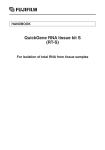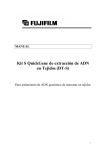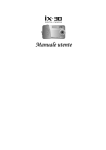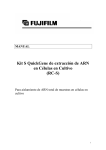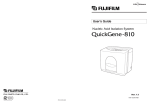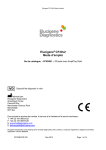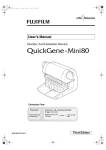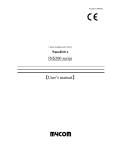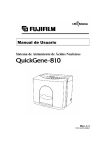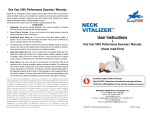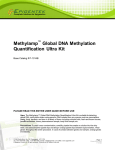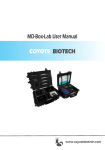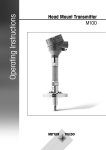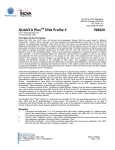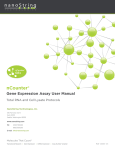Download QuickGene DNA tissue kit S (DT-S)
Transcript
HANDBOOK QuickGene DNA tissue kit S (DT-S) For Isolation of Genomic DNA from tissue samples Contents 1. 2. 3. 4. 5. 6. 7. 8. Introduction ................................................................................................... 4 Components of the kit .................................................................................. 4 Storage conditions ........................................................................................ 4 Other required materials, not supplied in this kit .......................................... 5 Safety warnings ............................................................................................ 6 Precautions .................................................................................................. 7 Quality controls ............................................................................................. 7 Protocols ...................................................................................................... 8 8-1 Preparation of reagents .............................................................................. 8 8-2 Sample preparations .................................................................................. 9 8-3 Genomic DNA isolation using the QuickGene-series Automatic Nucleic Acid Isolation System ...................................................................................... 14 9. Troubleshooting .......................................................................................... 16 10. Ordering Information .................................................................................. 17 11. Contact Information .................................................................................... 18 Appendix 1 ..................................................................................................... 19 Warning: For research use only. Not recommended and intended for diagnostic or clinical application for human and animals. 3 1. Introduction Fuji Photo Film Co., LTD developed and patented an evolutionary, porous membrane to immobilize nucleic acid. Because of its large specific surface area and uniform & fine porousness, QuickGene successfully isolates genomic DNA with high yield; moreover, with its patented thin membrane, it eliminates most contaminants. QuickGene also uses pressured filtration technology, which cannot be successfully utilized with typical glass membranes; by using pressured filtration technology, new, compact and automatic instruments for rapid nucleic acid purification can be produced successfully. When QuickGene DNA tissue kit S is used with the QuickGene-series Automatic Nucleic Acid Isolation System, high quality and high yield genomic DNA can be isolated and also purified from tissue samples. In addition, DNA from 8 sets of tissue lysate samples can be simultaneously extracted in only 13 minutes. The purified, high quality genomic DNA is suitable for PCR, restriction enzyme digestion, southern blotting and other applications. Please be sure to read this handbook carefully before using the kit. 2. Components of the kit The kit includes the reagents necessary for 96 sets of genomic DNA isolation. Proteinase K Tissue Lysis buffer Lysis buffer Wash buffer Elution buffer Cartridges Collection tubes Caps Waste tubes (EDT) (MDT) (LDT) (WDT) (CDT) (CA) (CT) (CAP) (WT) 3. Storage conditions Store all reagents at 15°C to 28°C. Storage of Proteinase K (EDT) at 2°C to 8°C is recommended to prolog the life, after open QuickGene DNA tissue kit S. 4 4. Other required materials, not supplied in this kit ◆ Reagents i >99% Ethanol i RNase A (Optional) ◆ Instruments and equipments i QuickGene-series Automatic Nucleic Acid Isolation System i 2 ml Micro-centrifuge tubes i Centrifuge tubes (see Table1) i Micropipettes and tips i Vortex mixer i Micro-centrifuge (c.a. 5,000×g) i Tube stands i Rotary shaker with heater Table1 Recommended centrifuge tubes. Size of QuickGene-series centrifuge-tube holder Standard Large Type of centrifuge tube Large centrifuge tube (for WDT) Product name (Examples) BD Falcon™ 50 ml conical tube Small centrifuge tube (for CDT) BD Falcon™ 15 ml conical tube Large centrifuge tube (for WDT) BD Falcon™ 175 ml conical tube BD Falcon™ 225 ml conical tube Small centrifuge tube (for CDT) BD Falcon™ 50 ml conical tube Centrifuge tubes are used with the QuickGene-series Automatic Nucleic Acid Isolation System as containers for the wash buffer (WDT) with ethanol and Elution buffer (CDT). Table2 Recommended Rnase A for optional process. Product Name Manufacture Cat. No Preparation Ribonuclease A Sigma R5125 1,2 Ribonuclease A Sigma R5500 1,2 Ribonuclease A Sigma R6513 1 Ribonuclease A Sigma R4642 Ribonuclease A MP Biomedicals 101076 1,2 RNase A AMRESCO 0675 1,2 RNase A QIAGEN 19101 RNase A Invitrogen 12091 Preparation 1, Prepare 100 mg/ml solution with 10 mM Tris-HCl (pH 7.5) and 15 mM NaCl 2, Incubate at 100°C for 15 min. to deactivate DNase 5 5. Safety warnings Warning: For research use only. Not recommended and intended for diagnostic or clinical application for human and animals. i All reagents and items should be considered chemically and biologically hazardous. Wearing a laboratory coat, gloves and safety glasses during the experiments are highly recommended. In case of contact between the reagents and the eyes, skin, or clothing, wash immediately with water. (See the Material Safety Data Sheet for specific recommendations, http://www.fujifilm.co.jp/msds) Proteinase K (EDT) Don’t put reagents in eyes and be careful of accidental ingestion. In case of contact between the reagents and eyes, skin or clothing, wash immediately with water. Tissue Lysis Buffer (MDT) Don’t put reagents in eyes and be careful of accidental ingestion. In case of contact between the reagents and eyes, skin or clothing, wash immediately with water. Lysis Buffer (LDT) Poisonous if swallowed Don’t put reagents in eyes and be careful of accidental ingestion. In case of contact between the reagents and eyes, skin or clothing, wash immediately with water. Wear laboratory coat, gloves and safety glasses during experiments. Wash Buffer (WDT) Don’t put reagents in eyes and be careful of accidental ingestion. In case of contact between the reagents and eyes, skin or clothing, wash immediately with water. Elution Buffer (CDT) Don’t put reagents in eyes and be careful of accidental ingestion. In case of contact between the reagents and eyes, skin or clothing, wash immediately with water. i Handle the Lysis buffer (LDT) in a well-ventilated area and keep away from heat, sparks, and flame. Keep container tightly closed. It might be harmful to inhale. Do not mix with disinfectants such as bleach. i For disposal of waste fluid and consumables: When using potentially infectious samples for experiments, dispose them according to applicable regulations. 6 6. Precautions i Refer to the MSDS (Material Safety Data Sheet) for specific recommendations on properties and handling. The MSDS can be obtained from the World Wide Website (http://lifescience.fujifilm.com). i Refer to the user’s manual for the QuickGene-series Automatic Nucleic Acid Isolation System before using. 7. Quality controls i The QuickGene DNA tissue kit S is specifically designed for genomic DNA isolation from 5 mg of tissue sample. i The stability of the reagents is guaranteed for one year after purchase if stored at the specified temperature (15°C to 28°C). i As part of the stringent of quality assurance program in Fuji Photo Film Co., LTD, the performance of QuickGene DNA tissue kit S is evaluated routinely on a lot-to-lot uniformity. i QuickGene DNA tissue kit S is tested for contaminations of other DNA, DNase and bacteria. i Quality and yield of isolated genomic DNAs are checked by measuring the absorbance at 260 nm, ratio of absorbance (260 nm/280 nm), and PCR amplification. 7 8. Protocols 8-1 Preparation of reagents Proteinase K (EDT) Storage of Proteinase K (EDT) at 2°C to 8°C is recommended to prolog the life, after open QuickGene DNA tissue kit S. Tissue Lysis Buffer (MDT) If the precipitates are contained in Tissue Lysis Buffer, incubate the bottle in a water bath at 55°C and mix with inversion the bottle intermittently until the precipitates are dissolved. After dissolving the Tissue Lysis Buffer, cool down the bottle to room temperature before using. Lysis Buffer (LDT) Mix thoroughly before using. If the precipitates are contained in Lysis Buffer, incubate the bottle in a water bath at 37°C and mix with inversion the bottle intermittently until the precipitates are dissolved. After dissolving the Lysis Buffer, cool down the bottle to room temperature before using. Wash Buffer (WDT) Add 160 ml of >99% ethanol into the bottle and mix with inversion the bottle gently at the beginning of use. Requirements of Wash Buffer (WDT) with >99% ethanol and Elution Buffer (CDT) Prepare the requirements of Wash Buffer (WDT) with >99% ethanol and Elution Buffer (CDT) according to the number of samples for isolation; refer to the following table. Take some of the buffers into each tube and set the tubes in the QuickGene-series system tube holder. (See the user’s manual of QuickGene-series Automatic Nucleic Acid Isolation System.) Table3 Buffer volume and the number of samples to set in the QuickGene System 8 Number of samples WDT with Ethanol 8 26 ml CDT 8 ml 16 44 ml 11 ml 24 62 ml 13 ml 32 80 ml 15 ml 40 99 ml 17 ml 48 117 ml 19 ml 56 135 ml 21 ml 64 154 ml 22 ml 72 172 ml 24 ml 80 190 ml 26 ml 88 209 ml 28 ml 96 227 ml 30 ml 8-2 Sample preparations i Basically, the QuickGene DNA tissue kit S is specifically designed for genomic DNA isolation from 5 mg of tissue sample. However it would be able to isolate the genomic DNA from 20 mg of tail of 6 weeks old female Balb/c mice. i The yield and preparation time may change with sample volume, variety of tissues, tissue storage condition and lysate condition. i 20 mg of Liver of 6 weeks old female Balb/c mice, would be able to isolate the genomic DNA without RNase treatment. Though the cartridge on QuickGene-series may clog or elution time may extend. When using more than 5 mg of Liver sample, RNA digestion may incomplete. Pretest the RNase treatment condition in this case. i 10 mg of Lung or Kidney of 6 weeks old female Balb/c mice, would be able to isolate the genomic DNA without RNase treatment. Though the cartridge on QuickGene-series may clog or elution time may extend. i Soak the 5 mg of sliced tissue in the Tissue Lysis Buffer (MDT) immediately. Freeze the lysate with liquid nitrogen and store at -20°C or -80°C if you do not prepare the samples immediately. i Keeping the samples at room temperature for a long time and/or repeatedly freezing or thawing degrades the genomic DNA or lowers the yield. i Accurately measure the buffer volume during the experiments. 9 <Preparation workflow from the mammalian tissue samples> 1. Tissue Lysis Empty 2 ml Micro-centrifuge Add slice of mammalians tissue: 5 mg *1a Add MDT: 180μl *1b Add EDT: 20μl *1c Incubate for over night on Rotary Shaker at 55°C, and dissolve the tissue completely *1d Flash spin down *1e Transfer the supernatant to new 1.5 ml micro tube 2. RNase Treatment (Optional) Add RNase A: 20μl *2a Tap the tube to mix the solution *2b Flash spin down *2c Set it down at room temperature for 2 min. 3. Addition of Lysis Buffer Add LDT: 180μl Mix thoroughly by vortexing for 15 sec. *3a Flash spin down Incubate at 70°C for 10 min. *3b Flash spin down 4. Addition of Ethanol Add >99% Ethanol: 240μl *4a Mix thoroughly by vortexing for 15 sec. *4b Flash spin down *4c Lysate *4d 5. Preparation with QuickGene-series Transfer the whole lysate to the cartridge of QuickGene-series Automatic Nucleic Acid Isolation System *5a Select “DNA TISSUE” mode Press Start Button Genomic DNA *5b Default elution volume; 200μl 10 Notice 1. Tissue Lysis 1a; Strictly maintain the sample volume at 5 mg during the experiments. It is ideal to cut the tissue into small pieces for quick dissolution. Keeping the samples at room temperature for a long time degrades the genomic DNA or lowers the yield. 1b; When the samples are frozen, thaw the samples to room temperature before using and soak them in the Tssue Lysis Buffer (MDT) immediately. When the samples are fresh, soak 5 mg of sliced tissues in the Tssue Lysis Buffer (MDT) immediately. 1c; Storage of Proteinase K (EDT) at 2°C to 8°C is recommended to prolog the life, after open QuickGene DNA tissue kit S. 1d; The incubation time may change depending on sample conditions and descriptions. Dissolve the tissue completely. 1e; If any aggregates are present in the lysate, remove them by centrifugation (8,000×g or 10,000 rpm, 3 min. at room temperature) or change the protocols by referring to troubleshooting. Dissolve the samples completely with shaking and incubation. 2. RNase Treatment (Optional) RNA would purify with Genomic DNA without RNase treatment. If the contaminant RNA has negative effects on next experiments, treat with RNase on this step. 2a; Use the recommended RNase (see 4 Other materials, not supplied in this kit). If you use the RNase (Invitrogen Cat #12091), add 60μl for each sample. 20μl of 100mg/ml RNase can digest the total RNA of 5 mg of liver tissue completely. 2b; Mix well the RNase and lysate. 2c; Flash spin down completely. 3. Addition of Lysis Buffer 3a; Mix completely with the Lysis Buffer (LDT) and sample solution. If the mixing is not enough by Vortex mixer, use the pipetting, tapping, inverting etc. 3b & 3d; Incubate the sample solution at 70°C if the solution becomes clouded at LDT addition step. 4. Addition of Ethanol 4a; Use >99% Ethanol 4b; Mix completely the sample solution and >99% ethanol. If the mixing is not enough by Vortex mixer, use the pipetting, tapping, inverting etc. 4c; If the solution becomes clouded after adding >99% ethanol (due to low room temperature), incubate the sample solution at 55°C. Cool down the samples to room temperature before next step. 4d; Transfer the whole lysate into the cartridge of QuickGene-series Automatic Nucleic Acid Isolation System. Perform isolation within 30 min. after lysate preparation. 5. Preparation with QuickGene-series 5a; Transfer the whole lysate into the cartridge of QuickGene-series Automatic Nucleic Acid Isolation System. Perform isolation within 30 min. after lysate preparation. 5b; Standard default elution volume is 200μl but you may change the setting of elution volume less than default volume, minimum 50μl. In case of setting to 50μl, yield may decline. 11 <Preparation workflow from the slice of mouse tail> 1. Tissue Lysis Empty 2 ml Micro-centrifuge Add slice of mouse tail: 5 mg *1a Add MDT: 180μl *1b Add EDT: 20μl *1c Incubate for over night on Rotary Shaker at 55°C, and dissolve the tissue completely *1d Flash spin down *1e Transfer the supernatant to new 1.5 ml micro tube 2. RNase Treatment (Optional) Add RNase A: 20μl *2a Tap the tube to mix the solution *2b Flash spin down *2c Set it down at room temperature for 2 min. 3. Addition of Reagents Add pre-mixed LDT (180μl) with >99% Ethanol (240μl): 420μl *3a Mix thoroughly by vortexing for 15 sec. *3b Flash spin down *3c Lysate *3d 4. Preparation with QuickGene-series Transfer the whole lysate to the cartridge of QuickGene-series Automatic Nucleic Acid Isolation System *4a Select “DNA TISSUE” mode Press Start Button Genomic DNA *4b Default elution volume; 200μl 12 Notice 1. Tissue Lysis 1a; Strictly maintain the slice of mouse tail volume at 5 mg (about 5 mm, but depending on the animals), during the experiments. Keeping the samples at room temperature for a long time degrades the genomic DNA or lowers the yield. 1b; When the samples are frozen, thaw the samples to room temperature before using and soak them in the Tissue Lysis Buffer (MDT) immediately. When the samples are fresh, soak 5 mg of sliced tissues in the Tissue Lysis Buffer (MDT) immediately. 1c; Storage of Proteinase K (EDT) at 2°C to 8°C is recommended to prolog the life, after open QuickGene DNA tissue kit S. 1d; The incubation time may change depending on the sample conditions and descriptions. Dissolve the tissue completely. 1e; If any coat or aggregates are present in the lysate, remove them by centrifugation (8,000×g or 10,000 rpm, 3 min. at room temperature) or change the protocols by referring to troubleshooting. Dissolve the samples completely by shaking and incubation. 2. RNase Treatment (Optional) RNA can purify with Genomic DNA without RNase treatment. If the contaminant RNA has negative effects on next experiments, treat with RNase on this step. 2a; Use the recommended RNase (see 4 Other materials, not supplied in this kit). If you use the RNase (Invitrogen Cat #12091), please add 60μl for each samples. 20μl of 100 mg/ml RNase (Sigma Cat # R5125) can digest the total RNA of 5 mg of Balb/c mouse (7 weeks old) tail completely. 2b; Mix well the RNase and lysate. 2c; Flash spin down completely. 3. Addition of Reagents 3a; Mix completely the Lysis Buffer (LDT) 180μl and >99% ethanol 240μl before using. 3b; Mix completely the Lysis buffer (LDT) and sample solution. If the mixing is not enough by Vortex mixer, use the pipetting, tapping, inverting etc. 3c; If the solution become clouded after adding >99% ethanol (due to low room temperature), incubate the sample solution at 55°C. Cool down the samples to room temperature before next step. 3d; Transfer the whole lysate into the cartridge of QuickGene-series Automatic Nucleic Acid Isolation System. Perform isolation within 30 min. after lysate preparation. 4. Preparation with QuickGene-series 4a; Transfer the whole lysate into the cartridge of QuickGene-series Automatic Nucleic Acid Isolation System. Perform isolation within 30 min. after lysate preparation. 4b; Standard default elution volume is 200μl but you may change the setting of elution volume less than default volume, minimum 50μl. In case of setting to 50μl, yield may decline. 13 8-3 Genomic DNA isolation using the QuickGene-series Automatic Nucleic Acid Isolation System Notice: System set up and basic operations Please read the user’s manual of QuickGene-series Automatic Nucleic Acid Isolation System circumstantially for the details before using the system. Please take “Discharge” before isolation with QuickGene-series Automatic Nucleic Acid Isolation System, every time. (1) Selection of isolation mode Select “DNA TISSUE” mode for genomic DNA isolation with the kit. (See Appendix 1) (2) Setting of cartridges and tubes Open the front cover of the instrument and set the collection and waste tubes in the collectiontube holder. i Use the specified Collection Tubes (CT) and Waste Tubes (WT) including the kit. Attach the cartridge holder to the instrument and set 1~8 cartridges in the cartridge holder. i Use the specified Cartridges (CA). Notice: Refer to the user’s manual for the QuickGene-series Automatic Nucleic Acid Isolation System for details of setting cartridges and tubes. Incorrect cartridge placement may result in the solution spilling or improper isolation. Wear gloves during the experiments to avoid nuclease contamination. (3) Setting of reagents Prepare the required volume (see 8-1 Preparation of regents) of Wash Buffer (WDT) with >99% ethanol and Elution Buffer (CDT) into the tubes; set them to the holder; and put the holder to the designated positions of instrument. Notice: Wear gloves during the handling of reagents to avoid nuclease contamination. i Read the user’s manual for the QuickGene-series Automatic Nucleic Acid Isolation System for details for setting reagents. The standard default elution volume is 200μl but you may change the setting of elution volume less than default volume, minimum 50μl. In case of setting to 50μl, yield may decline. (4) Discharge Set the “discharge tray” and check the collection holder and cartridge holder setting for the correct positions. Press the “DISCHARGE” after closed the front cover of the instrument. Notice: Because of air in the lines, incorrect volume of reagents may occur without discharge operation. (5) Applying the prepared samples Apply all contents of prepared lysate samples (see 8-2 Sample preparation) into the each Cartridge (CA) by using micropipettes (any aggregates in the lysate should be transfered into the cartridge). (6) Isolation Check if the materials—Wash Buffer (WDT) with >99%ethanol, Collection Buffer (CDT), Cartridges (CA) including samples, Waste Tubes (WT), and Collection Tubes (CT)—are well set. Close the front cover of the instrument. Confirm the appropriate mode on the operation panel and press the [START] button. 14 (7) Collection of genomic DNA After completing the process, each sample result is indicated on the operation panel as follow; v (Check): Completed normally – (Hyphen): Not completed normally _ (Underscore): No cartridge or no sample Open the front cover and remove the Collection Tube(s) (CT) from the collection-tube holder. i As genomic DNA is eluted from the Cartridge(s) (CA) using 200μl of Elution Buffer (CDT), the volume of recovered total DNA solution will be 200μl. Cover with the Caps (CAP) on the Collection Tubes (CT) containing the isolated genomic DNA. (8) Clean up Remove the Waste Tubes (WT) and dispose the waste fluid according to applicable regulations. Remove the cartridge holder and dispose the Cartridges (CA). Warning: Disposal of waste fluid and consumables When using the potentially infectious samples for experiments, dispose them according to applicable regulations. 15 9. Troubleshooting Review the information below to troubleshoot the experiments with QuickGene DNA tissue kit S. For system-related problems (e.g., when an error message appears), see the QuickGene-series user’s manual. (1) Low yield or no DNA obtained Cause Possible Solution Storage condition of sample Incorrect storage condition induces low yield. Try different storage conditions that may vary with sample volume and storage period. Incompletely dissolved samples Soak the 5 mg of sliced tissues in the Tissue Lysis Buffer (MDT) with ProteinaseK immediately. Cut the tissue into small pieces. Extend the incubation time in the lysis step. Dissolve the tissue completely with shaking and incubation. Prepare the sample volume to 200μl before LDT addition. Reagents and tissues added in the wrong order Add the reagents to micro tubes in the following order when preparing the lysate from tissues: Tissue lysate ➝ Lysis Buffer (LDT) ➝ 99% ethanol, or mouse tail lysate ➝ Lysis Buffer (LDT) with >99% ethanol mixture Too much tissues Reduce the amount of tissues below the specified amount. Insufficient homogenization following the addition of Lysis Buffer (LDT) Vortex sufficiently (15 sec.) immediately after Lysis Buffer (LDT) addition. Required volume of ethanol was not added to Wash Buffer (WDT) Always confirm that the required volume of ethanol is added to the Wash Buffer (WDT) prior to use. Old Wash Buffer (WDT: including ethanol) was used Flash remaining wash buffer (WRC: including ethanol) which may be one day old or more in the instrument prior to use. Lysate is not fully applied to Cartridge(s) (CA) If aggregates are present in the lysate, apply them along with the lysate to the cartridge. Insufficient amounts of reagents used Make sure that sufficient amount of reagent are in the reagent bottles. Supplying the precipitates in reagents See (4) section (2) Clogging the cartridge Cause 16 Possible Solution Excess amount of tissues were used Reduce the amount of tissues below the specified amount. Insufficient homogenization following the addition of Lysis Buffer (LDT) Vortex sufficiently (15 sec.) immediately after Lysis Buffer (LDT) addition. Incomplete dissolved samples See (1) section Clogging the cartridge with insoluble Remove the insoluble with centrifuge before Lysis Buffer (LDT) is added. (3) Subsequent experiments (e.g., PCR) unsuccessful Cause Possible Solution Improper amount of DNA used for subsequent experiments Determine the concentration based on the absorbance at 260 nm. Genomic DNA would degrade Soak the 5 mg of sliced tissues in the Tissue Lysis Buffer (MDT) immediately or freeze the lysate with liquid nitrogen and store at -20°C or -80°C if you do not prepare the samples immediately. (4) Supplying the precipitates in reagents Cause Stored at low temperature Possible Solution Store at 15°C to 28°C If the precipitates are contained, incubate the bottle of MDT in a water bath at 55°C and bottle of LDT at 37°C and mix with inversion the bottle intermittently until the precipitates are dissolved. (5) Solutions become clouded after adding >99% ethanol in preparation workflow from the mammalians tissue or LDT with adding >99% ethanol mixture in preparation workflow from the slice of mouse tail. Cause Low temperature Possible Solution Incubate the sample solution at 55°C to dissolve and cool down the samples to room temperature before next step. (6) The collection tubes are empty after the elution. Cause Missed the discharge Possible Solution Set the “discharge tray” and check the collection holder and cartridge holder settings into correct positions. Press the “DISCHARGE” after closing the front cover of the instrument. See the QuickGene-series user’s manual. 10. Ordering Information Product Cat # QuickGene-series Automatic Nucleic Acid Isolation Systems QuickGene DNA tissue kit S DT-S Dedicated reagent kit for QuickGene-series to isolate the Genomic DNA from the tissue QuickGene DNA whole blood kit S DB-S Dedicated reagent kit for QuickGene-series to isolate the Genomic DNA from whole blood QuickGene RNA tissue kit S RT-S Dedicated reagent kit for QuickGene-series to purify the total RNA from the tissue QuickGene RNA cultured cell kit S RC-S Dedicated reagent kit for QuickGene-series to purify the total RNA from cultured cell QuickGene Plasmid kit S PL-S Dedicated reagent kit for QuickGene-series to extract the Plasmid DNA Trade Mark; Falcon™ (Becton, Dickinson and Company) The Polymerase Chain reaction (PCR) is covered by patents owned by Roche Molecular Systems and F Hoffmann-La Roche Ltd. 17 11. Contact Information http://lifescience.fujifilm.com Fuji Photo Film Co., Ltd. LIFE SCIENCE, PHOTO IMAGING & INFORMATION PRODUCTS DIVISION 26-30, Nishiazabu 2-Chome, Minato-ku, TOKYO 106-8620, JAPAN Tel: +81-3-3406-2201 Fax: +81-3-3406-2158 E-mail: [email protected] Subsidiaries <United States, Canada, Mexico> Fujifilm Medical System U.S.A.,Inc. 419 West Avenue, Stamford, CT 06902, U.S.A. Tel: +1-203-324-2000 ext.6112 (1-800-431-1850 ext. 6112 in the U.S.) Fax: +1-203-351-4713 E-mail: [email protected] URL: http://lifescience.fujifilm.com/ <Europe (excl. UK and Ireland)> Fuji Photo Film (Europe) GmbH, Heesenstr. 31, 40549 Dusseldorf, Germany, Tel: +49-211-5089-174 Fax: +49-211-5089-139 E-mail: [email protected] URL: http://www.fujifilm.de <UK, Ireland> Fuji Photo Film (U.K) Unit 12, St Martin•fs way, St Martin’s Business centre, Bedford, MK42 QLF UK Tel: +44-1234-245291 Fax: +44-1234-245293 E-mail: [email protected] URL: http://lifescience.fujifilm.com/ <China> Fuji Photo Film (China) Investment Co., Ltd. 31st floor, Hong Kong New World Tower, No.300 Huai Hai Zhong Road, P.R China Tel: +86-21-3302-4655 Fax: +86-21-6384-3322 E-mail: [email protected] URL: http://www.fujifilm.com.cn Distributors <Australia / New Zealand> Berthold AUSTRALIA PTY Ltd. 40 Clements Ave., Bundoora, Victoria 3083, Australia Tel: +61-3-9467-6277 Fax: +61-3-9467-7493 E-mail: [email protected] URL: http://berthold.com.au <Korea> Shinki Hi-Tec GUNWHA Bldg. 7-1, Yangjae, 1-dong, Secho-gu, Saoul, 113-887 Korea Tel: +82-2-572-1600 Fax: +82-2-572-0058 E-mail: [email protected] URL: http://www.skhitec.co.kr <Taiwan> HUNG CHONG CORP. No.38, Sec. 6, Min Chuan E Road, Taipei, Taiwan Tel: +886-2-2791-1188 Fax: +886-2-2794-2248 E-mail: [email protected] URL: http://www.FUJIFILM.COM.TW 18 Appendix 1 “DNA TISSUE” mode is set in the following parameter. DNA TISSUE PARAMETER SET VALUE BIND PEAK 120 WASH COUNT 3 WASH PEAK 110 WASH VOL1 750 WASH VOL2 750 WASH VOL3 750 WASH VOL4 750 WASH VOL5 750 WASH DIP TM 0 WAS2 WAIT T 0 WAS2 COUNT 0 WAS2 PEAK 110 WAS2 VOL1 750 WAS2 VOL2 750 WAS2 VOL3 750 WAS2 VOL4 750 WAS2 VOL5 750 ELUT VOL 200 ELUT PEAK 100 ELUT DIP TM 90 19



















